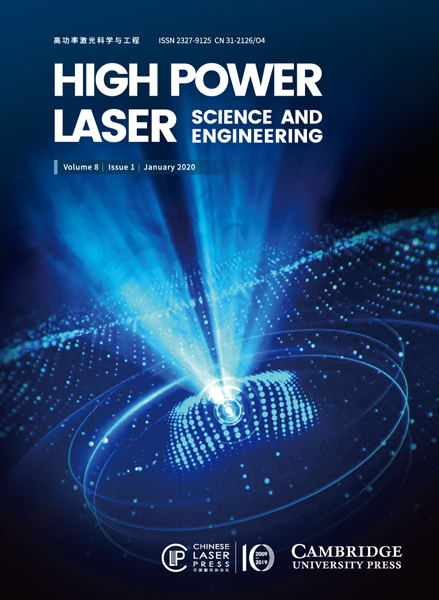2017, 5(3) Column
High Power Laser Science and Engineering 第5卷 第3期
Targets have been developed to measure supersonic radiation transport in aerogel foams using absorption spectroscopy. The target consists of an aerogel foam uniformly doped with either titanium or scandium inserted into an undoped aerogel foam package. This creates a localized doped foam region to provide spatial resolution for the measurement. Development and characterization of the foams is a key challenge in addition to machining and assembling the two foams so they mate without gaps. The foam package is inserted into a beryllium sleeve and mounted on a gold hohlraum. The target is mounted to a holder created using additive manufacturing and mounted on a stalk. The manufacturing of the components, along with assembly and metrology of the target are described here.
absorption spectroscopy doped foams radiation transport Muons produced by a short pulse laser can serve as a new type of muon source having potential advantages of high intensity, small source emittance, short pulse duration and low cost. To validate it in experiments, a suitable muon diagnostics system is needed since high muon flux generated by a short pulse laser shot is always accompanied by high radiation background, which is quite different from cases in general muon researches. A detection system is proposed to distinguish muon signals from radiation background by measuring the muon lifetime. It is based on the scintillator detector with water and lead shields, in which water is used to adjust energies of muons stopped in the scintillator and lead to against radiation background. A Geant4 simulation on the performance of the detection system shows that efficiency up to 52% could be arrived for low-energy muons around 200 MeV and this efficiency decreases to 14% for high-energy muons above 1000 MeV. The simulation also shows that the muon lifetime can be derived properly by measuring attenuation of the scintilla light of electrons from muon decays inside the scintillator detector.
diagnostics Geant4 simulation muon source short pulse laser A number of laser facilities coming online all over the world promise the capability of high-power laser experiments with shot repetition rates between 1 and 10 Hz. Target availability and technical issues related to the interaction environment could become a bottleneck for the exploitation of such facilities. In this paper, we report on target needs for three different classes of experiments: dynamic compression physics, electron transport and isochoric heating, and laser-driven particle and radiation sources. We also review some of the most challenging issues in target fabrication and high repetition rate operation. Finally, we discuss current target supply strategies and future perspectives to establish a sustainable target provision infrastructure for advanced laser facilities.
high-energy density physics target design and fabrication Inertial confinement fusion targets are complex systems designed to allow fine control of temperature and pressure for making precise spherical ice layers of hydrogen isotopes at cryogenic temperatures. We discuss the various technical considerations for a maximum leak rate based on heat load considerations. This maximum flow rate turns out to be $5\times 10^{-6}$ standard cc per second, which can be caused by an orifice less than half a micron in diameter. This makes the identification of the location and resolution of the leak a significant challenge. To illustrate this, we showcase one example of a peculiar failure mode that appeared suddenly but persisted whereby target production yield was severely lowered. Identification of the leak source and the root cause requires very careful analysis of multiple thermomechanical aspects to ensure that the end solution is indeed the right remedy and is robust.
cryogenic leak rate target In indirect drive, reducing peak intensity of a single beam and controlling overlap of multi-beams are two opposite requirements for laser focal spot design. In this paper, an improved laser spot design technique for indirect drive built upon the geometric structures of laser propagation into hohlraum has been introduced. The proposed technique is able to generate appropriate continuous phase plate (CPP) producing a special shaped spot that can balance the opposite requirements. The corresponding CPP does not bring difficulties to the design and fabrication. Phase aberrations are more sensitive to the special shaped spot; however, it can be tolerable for the current beam control level.
beam aberration CPP focal spot optimization ICF Laser systems Outside surface fluctuations of inertial confinement fusion (ICF) capsule greatly affect the implosion performance. An atomic force microscope (AFM)-based profilometer is developed to precisely characterize the capsule surface with nanometer resolution. With the standard nine surface profiles and the complete coverage data, 1D and 2D power spectra are obtained to quantitatively qualify the capsule. Capsule center fast aligning, orbit traces automatic recording, 3D capsule orientation have been studied to improve the accuracy and efficiency of the profilometer.
inertial confinement fusion target design and fabrication This paper describes the design and fabrication of a range of ‘gas cell’ microtargets produced by the Target Fabrication Group in the Central Laser Facility (CLF) for academic access experiments on the Orion laser facility at the Atomic Weapons Establishment (AWE). The experiments were carried out by an academic consortium led by Imperial College London. The underlying target methodology was an evolution of a range of targets used for experiments on radiative shocks and involved the fabrication of a precision machined cell containing a number of apertures for interaction foils or diagnostic windows. The interior of the cell was gas-filled before laser irradiation. This paper details the assembly processes, thin film requirements and micro-machining processes needed to produce the targets. Also described is the implementation of a gas-fill system to produce targets that are filled to a pressure of 0.1–1 bar. The paper discusses the challenges that are posed by such a target.
astrophysics microtargets 动态信息
动态信息 丨 2023-06-21
HPL Highlight (Vol. 11, e40): NIF仍然是全球唯一一个能够进行ICF点火实验的装置动态信息 丨 2023-06-21
HPL Highlight (Vol. 11, e9): 变分神经网络预测激光尾波场加速电子能谱动态信息 丨 2023-06-21
HPL Highlight (Vol. 11, e7): 目标探测网络加入,激光等离子体加速器实现实时诊断动态信息 丨 2023-06-21
HPL Highlight (Vol. 11, e5): 910 nm波段超宽带种子源,向100 PW超强超短激光进发动态信息 丨 2023-06-21
HPL Highlight (Vol. 11, e4): 100 PW单束压缩!多步压缩器进阶双光栅激光评论微信公众号

点击菜单“联系编辑”即可添加期刊编辑为好友啦












